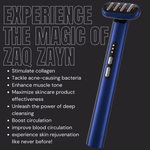In our previous post,
Beginner’s Guide to Aromatherapy: Part 1, we defined aromatherapy, gave you a list of starter essential oils and covered the two main methods of aromatherapy – diffusing and applying. You can also inhale concentrated essential oils, but that’s a more advanced form for another day.
The Blends
So what do you do if you’ve found a few essential oils you like, but they don’t quite pack the punch you were hoping for. Or, alone, they fall a bit… flat… in the sensory department? That’s where an essential oil blend comes into play. Blending essential oils gives your aromatherapy depth. Like when you’re listening to a flute play a beautiful melody, and the piano joins in with the harmony. Add one or two essential oils into a blend and create a symphony for your mind. Ok, enough with the music metaphor. Time to walk you through your beginner’s guide to blending:
Pick your theme Are you looking for an energizing blend or something more relaxing? Do you need help concentrating or focusing on a project? Before you can choose your essentials oils or even separate them into categories, you need to give your blend a purpose – it needs a reason for existing! When you have that reason, Google the
best essential oils for that theme/purpose and make a list of the ones you like.
Or, if you want a quick visual, take a look here.
Separate your list into categories and notes Once you have your list of essential oils, separate them into “category” and “notes”. Doing this will help you when you choose which essential oils to blend together. The best thing to do when you’re first starting out is to blend only three oils (more about why in the “notes” section). Once you get more experienced at it, you can try more oils in your concoction!
Category All essential oils fit into a few specific categories.
Floral (ex. lavender and rose) Woody (ex. cedar and pine) Earth (ex. patchouli and vetiver) Herbaceous (ex. Basil and rosemary) Mint (ex. Peppermint and spearmint) Medicinal (ex. Eucalyptus and tea tree) Spicy (ex. Cinnamon and ginger) Citrus (ex. Orange and lemon)
Each category blends with others differently, and sometimes with success … or without. Knowing which categories of essential oils work will help you decide which three essential oils to blend together.
Floral – woody, spicy, citrus Woody – floral, earth, herbaceous, mint, medicinal, spicy, citrus Earth – woody, mint Herbaceous – woody, mint Mint – woody, earth, herbaceous, citrus Medicinal – woody Spicy – floral, woody, citrus Citrus – floral, woody, mint, spicy
Notes After you’ve sorted through the categories and made your short list of essential oils it’s time to pick your top three. The best way to do so is to decide on the top, middle and base notes of your blend. “Notes” are the way smells appear on the nose – top notes are the first you notice, followed by middle and then base notes. These notes also evaporate at different rates, with the top dissipating first, then the middle and then the base. This means that your blend will smell differently three hours after you’ve applied it than it did when you first put it on.
Dean Coleman’s website explains all of this a lot better, with a chart listing where each essential oils falls – if it’s a top, middle or base note. If you’re going to use three essential oils, pick one top, one middle and one base essential oil. If you plan to only blend two, use a top and a bottom essential oil.
Experimentation time Now it’s time to test out your blend to see if it smells as sweet as you’d hoped! For your experiment, stick to using 10 drops total (so all two or three blends total make 10 drops). For example, if you’re using a top, middle and base note version of essential oils, then do 30% top, 50% middle and 20% base notes. One note of caution: this is just the experimental stage and you’re using concentrated essential oils, so try not to get it on your skin. Wear gloves if you can. Also, the smell will be a lot stronger than if you put it in a diffuser or in a carrier oil.
Take a rest Great job! Now you can take a rest (and so can your blend). Leave the blend for 24 to 48 hours so that all the components can befriend each other and party.
Testing time After the rest period is over, take a whiff of your blend. If you like it, test it out in your carrier oil or in your diffuser. If you don’t like it, return to step one and start the fun process all over again.
The Alternatives
While diffusing and applying essential oils are the common methods of aromatherapy, there are other ways to keep that going all day long. You can
incorporate essential oils into every room of your home, for example. It is also used in hair care,
skin care and
bug bites! If you’re curious about the different ways you can incorporate aromatherapy into your everyday life, keep watch on our blog because we’re always exploring the world of aromatherapy.
Do you have any tips or tricks when it comes to aromatherapy? Share them with us and our community on Facebook!













































